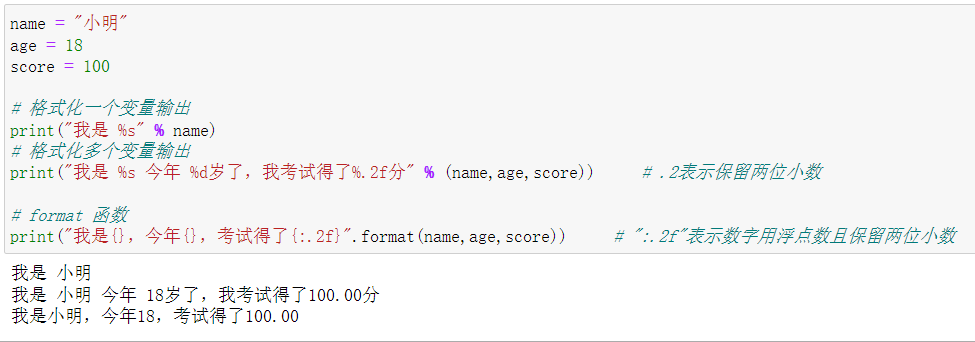1. Notes
1.1 notes - single line notes
① "#" is a single line annotation, and the Python interpreter will ignore the input after #, and will not execute it.
② # can be placed on the top and right of the code.
③ long press the left mouse button to select a single line or multiple lines of code, and press Ctrl + / to directly annotate them as single line comments
# I love God Li Linghua
print("Shenli Linghua is my wife.") # The print() function prints the content to the console

1.2 comments - multiline comments
① three quotation marks (single quotation marks and double quotation marks) are multiline annotators. The Python interpreter will ignore the contents within the quotation marks and will not execute them.
② multi line comments cannot be placed on the right side of the code.
"""
I love Ling Hua
Ling Hua loves me
"""
'''
I love the son of God
The son of God loves me
'''
print("Ling Hua is my wife.")

2. Variables
2.1 variable - variable concept
in short, a variable is a code used to store data.
age=18
at this time, age is a variable, and the variable value is 18.
2.2 variables - naming rules
① must start with English letter (recommended), underline or Chinese (not recommended).
② variable names can only be composed of English letters, numbers, underscores or Chinese characters.
③ English letters are case sensitive. Age and age are two different variable names.
④ Python built-in functions and reserved words cannot be used as variable names.
3. Data type
six basic data types of Python: number (int,float), string (str), list (list), Dictionary (dictionary), tuple (tuple), set (set).
3.1 data type - numeric type
3.1.1 numeric type - integer int
integer refers to a number without decimal point (positive integer, negative integer, 0).
a=10 b=-10 c=0 print(a,b,c)

3.1.1 number type - float ing point
floating point refers to a number with a decimal point.
a=10.5 b=3.1415926 c=-0.55 print(a,b,c)

3.2 data type - string type str
① a string is a combination of characters.
② put the string content in a pair of quotation marks (quotation marks can be single, double or three quotation marks).
a='I love China' b="I love China" c='''I love China''' print(a) print(b) print(c)

③ string numbers cannot participate in arithmetic operation (both str+int and str+float report errors).
a='10' # String type b=10 # Integer type c=20.5 # Floating point type print(a) print(b) print(a+b) print(a+c) print(b+c)
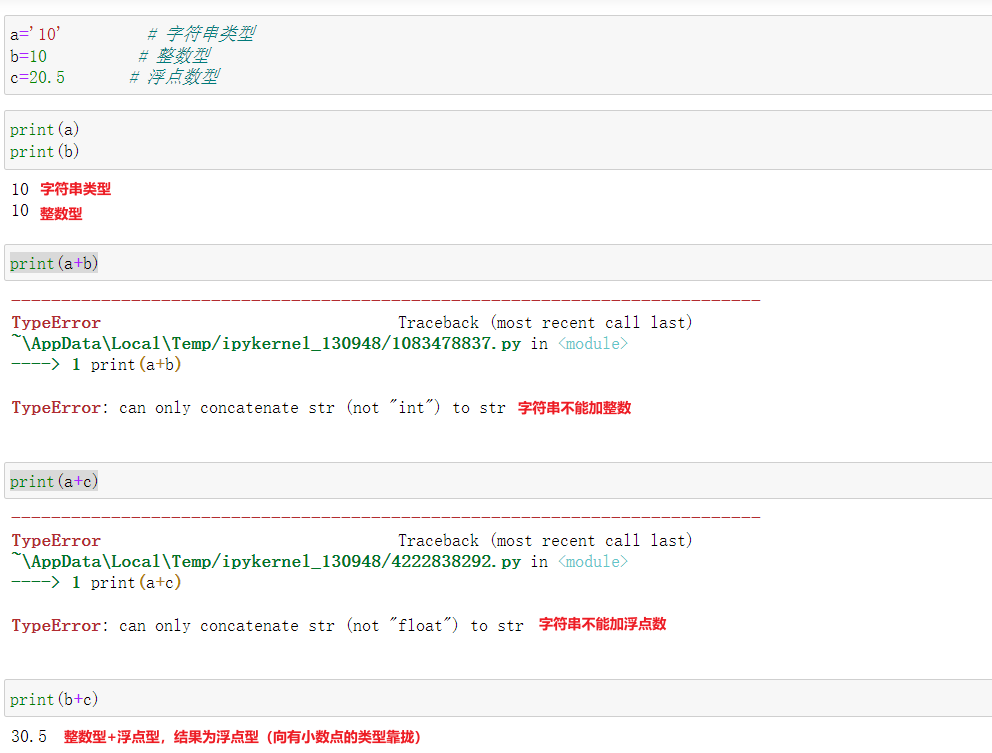
④ quotation marks cannot be mixed. For example, a pair of quotation marks must be followed by a single quotation mark.
a="I'am XiaoMing" print(a)

3.3 data type - list type
3.3.1 list type - definition list
list name = [element 1, element 2, element 3...]
My_list = ["Eight God son","Shenli Linghua","Ke Qing","Cory","Barbara "] print(My_list)

of course, the elements of the list can be strings, numbers, or even another list.
My_list = ["Zhong Li",1314,[1,2,3]] print(My_list)

3.3.2 list type - traversal list
My_list = ["Eight God son","Shenli Linghua","Ke Qing","Cory","Barbara "]
for i in My_list: # Take out the elements in the list from left to right
print(i)

3.3.3 list type - count the total number of all elements in the list
len (list name)
My_list = ["Eight God son","Shenli Linghua","Ke Qing","Cory","Barbara "] a = len(My_list) print(a)

3.3.4 list type - counts the total number of occurrences of a single element in the list
my_list = ["Eight God son","Shenli Linghua","Eight God son","Eight God son","Barbara ","Eight God son","timely rain","Condensing light"]
nums1 = my_list.count("Eight God son")
print(nums1)
my_list = ["Eight God son","Shenli Linghua","Ke Qing","Cory","Barbara ","Diona ","timely rain","Condensing light"]
nums2 = my_list.count("Diluk") # 0 is returned when the value to be found is not found in the list
print(nums2)

3.3.5 list type - Retrieve element index
my_list = ["Eight God son","Shenli Linghua","Ke Qing","Cory","Barbara "]
ke1 = my_list.index("Cory") # Find the subscript (index) corresponding to the element "Cori"
print(ke1)
my_list = ["Eight God son","Shenli Linghua","Ke Qing","Cory","Barbara "]
ke2 = my_list.index("Diluk") # The element "diluk" is not in the list and an error is reported
print(ke2)
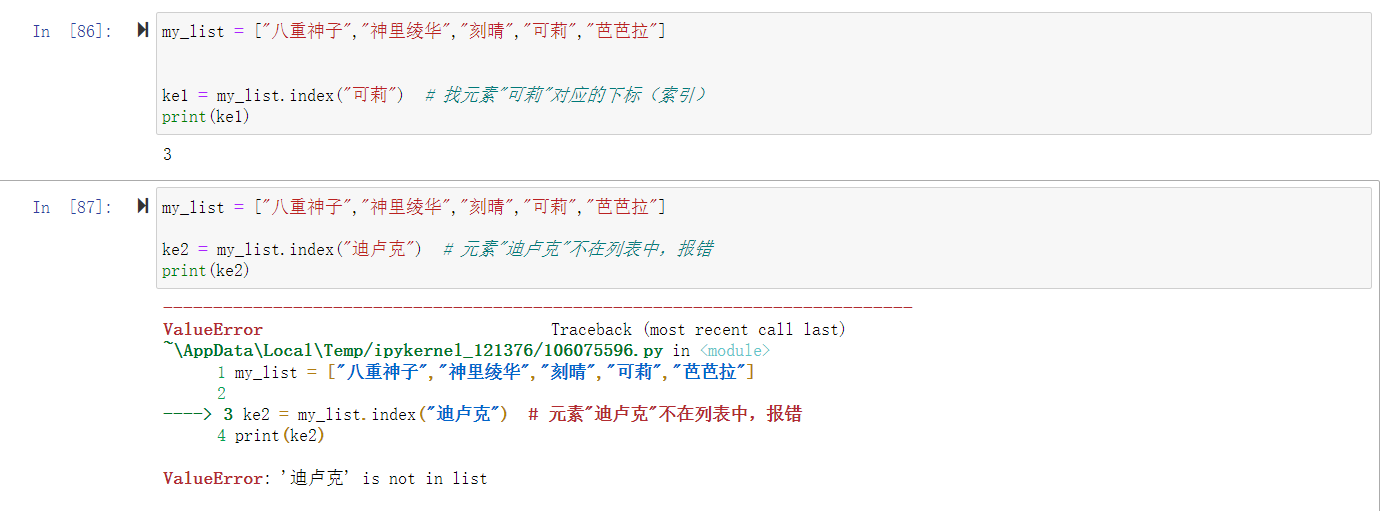
3.3.6 list type - extracts a single element from a list
list name [subscript]
My_list = ["Eight God son","Shenli Linghua","Ke Qing","Cory","Barbara "] a = My_list[2] print(a)

3.3.7 list type - extract multiple elements of the list (list slice)
My_list = ["Eight God son","Shenli Linghua","Ke Qing","Cory","Barbara ","Diona ","timely rain","Condensing light"] a = My_list[1:4] print(a) a = My_list[1:] print(a) a = My_list[:4] print(a) a = My_list[:] print(a) a = My_list[::2] print(a) a = My_list[::-1] print(a) a = My_list[-2:] print(a) a = My_list[:-2] print(a)
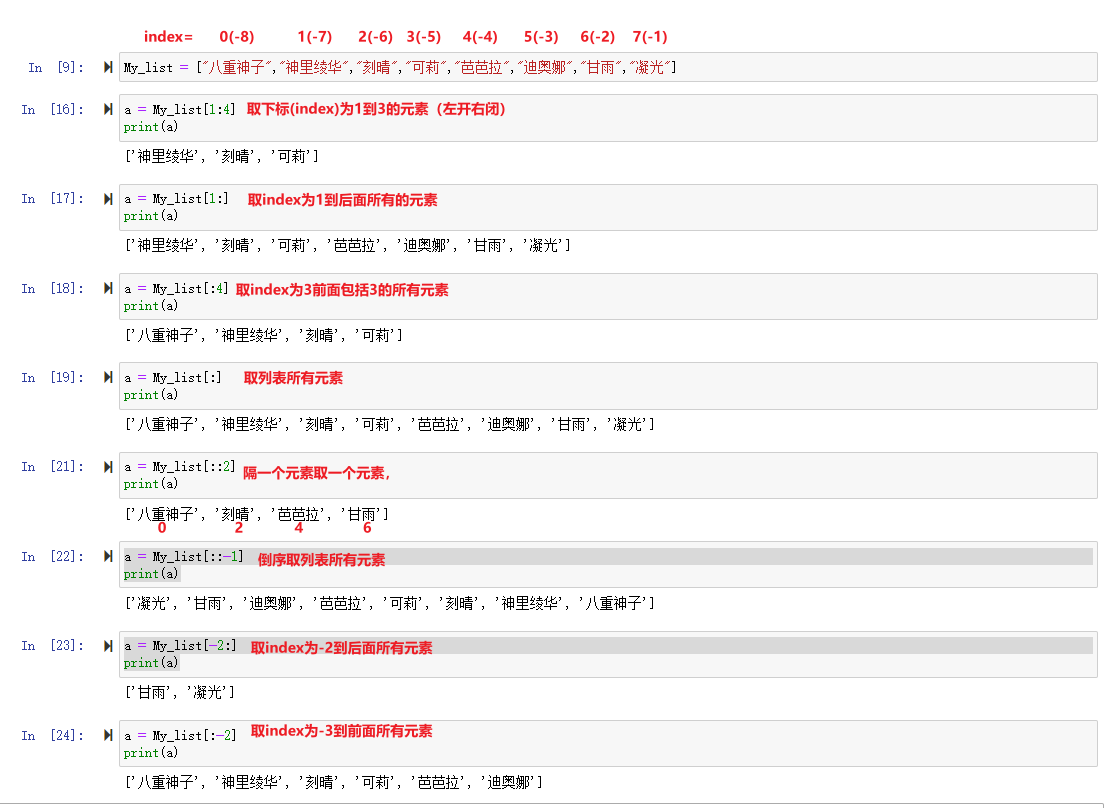
3.3.8 list type - add elements at the end of the list
list name Append (element)
My_list = [] # Create an empty list
My_list.append("Eight God son")
print(My_list)
My_list.append("timely rain")
print(My_list)

3.3.9 list type - list insert element
my_list = ["timely rain", "Shen He", "Piano"] my_list.insert(1, "12306") print(my_list)

3.3.10 list type - modify list elements
list name [subscript] = element
My_list = ["Eight God son","Shenli Linghua","Ke Qing","Cory","Barbara "] My_list[2] = 1314 print(My_list)

3.3.11 list type - summation of list elements (all elements are numeric)
My_list = [1,2,3,4,5,6] print(sum(My_list))

3.3.12 list type - maximum and minimum values of list elements (all elements are numeric)
My_list = [1,2,3,4,5,6] print(max(My_list)) # Take the maximum value print(min(My_list)) # Take the minimum value

3.3.13 list type - list to string
convert the list into a string connected with a connector (comma, semicolon, etc., or don't write it into a sentence at all)
'connector' Join (list name)
My_list = ["Eight God son","Shenli Linghua","Ke Qing","Cory","Barbara "] a = ','.join(My_list) print(a) a = ''.join(My_list) print(a)

3.3.14 list type - string to list
string split("separator")
a = "I always like Shenli Linghua"
My_list=a.split(" ")
print(My_list)
My_list=a.split(",")
print(My_list)

3.3.15 list type - list addition
my_list1 = ["Shenli Linghua","Eight God son"] my_list2 = ["Shen He"] my_list3 = my_list1 + my_list2 print(my_list3)

3.3.16 list type - list multiplication
my_list1 = ["Shenli Linghua","Eight God son"] my_list2 = my_list1 * 2 print(my_list2)

3.3.17 list type - delete list elements
① del delete
my_list = ["Eight God son","Shenli Linghua","Ke Qing","Cory","Barbara ","Diona ","timely rain","Condensing light"] # Delete an element by index del my_list[0] print(my_list)
my_list = ["Eight God son","Shenli Linghua","Ke Qing","Cory","Barbara ","Diona ","timely rain","Coagulate>light"] # Delete list interval elements by index del my_list[0:3] print(my_list)
my_list = ["Eight God son","Shenli Linghua","Ke Qing","Cory","Barbara ","Diona ","timely rain","Condensing light"] # Delete list interval elements by index del my_list[0:3:2] print(my_list)
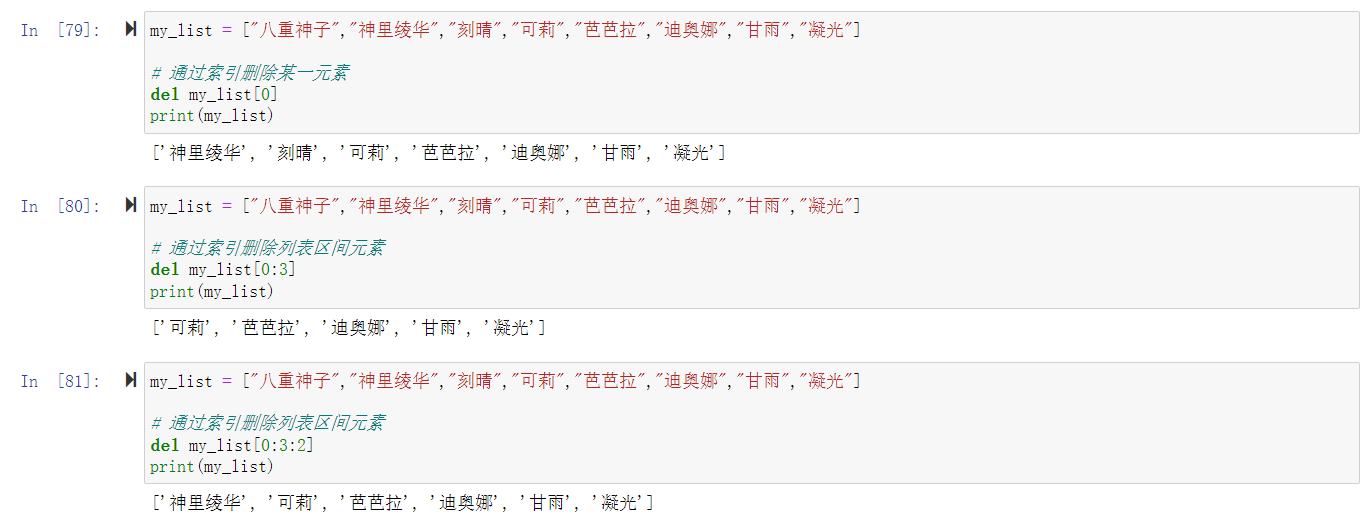
② pop() function
my_list = ["Eight God son","Shenli Linghua","Ke Qing","Cory","Barbara ","Diona ","timely rain","Condensing light"] my_list.pop(1) # My without subscript_ list. Pop() deletes the last item by default print(my_list)

③ remove() function
my_list = ["Eight God son","Shenli Linghua","Ke Qing","Cory","Barbara ","Diona ","timely rain","Condensing light"]
my_list.remove("Ke Qing")
print(my_list)

3.3.18 list type - sort
① sort from small to large
my_list = [3, 4, 1, 2, 9, 8, 7]
print("Before sorting:", my_list)
my_list.sort()
print("After sorting:", my_list)
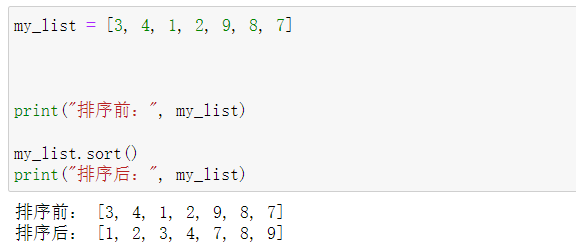
② sort from large to small
my_list = [3, 4, 1, 2, 9, 8, 7]
print("Before sorting:", my_list)
my_list.sort(reverse=True)
print("After sorting:", my_list)
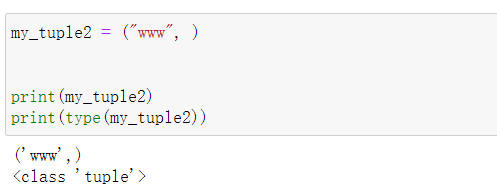
3.4 data type - dictionary type
3.4.1 dictionary type - Definition Dictionary
dictionary name = {key 1: value 1, key 2: value 2, key 3: value 3...}
my_dict = {"Xiao Ming":85,"Xiao Hong":76,"Xiaolan":97,"Little green":100}
print(my_dict)

3.4.2 dictionary type - get value by key
my_dict = {"Xiao Ming":85,"Xiao Hong":76,"Xiaolan":97,"Little green":100}
a = my_dict["Xiao Ming"]
print(a)

3.4.3 dictionary type - add element
my_dict = {"Xiao Ming":85,"Xiao Hong":76,"Xiaolan":97,"Little green":100}
my_dict["Xiao Hei"] = 60
print(my_dict)

3.4.4 dictionary type - modify element
my_dict = {"Xiao Ming":85,"Xiao Hong":76,"Xiaolan":97,"Little green":100, "Xiao Hei": 60}
my_dict["Xiao Hei"] = 13
print(my_dict)

3.4.5 dictionary type - delete element
my_dict = {"Xiao Ming":85,"Xiao Hong":76,"Xiaolan":97,"Little green":100, "Xiao Hei": 60}
del my_dict["Xiao Hei"]
print(my_dict)

3.4.6 dictionary type - empty dictionary
my_dict = {"Xiao Ming":85,"Xiao Hong":76,"Xiaolan":97,"Little green":100, "Xiao Hei": 60}
my_dict.clear()
print(my_dict)

3.4.7 dictionary type - traverse key value pairs
# Directly to my_dict traversal
my_dict = {"Xiao Ming":85,"Xiao Hong":76,"Xiaolan":97,"Little green":100, "Xiao Hei": 60}
for item in my_dict:
print(item)
# Traverse my_ items method of Dict
my_dict = {"Xiao Ming":85,"Xiao Hong":76,"Xiaolan":97,"Little green":100, "Xiao Hei": 60}
for item in my_dict.items():
print(item)
# Traverse my_ The items method of dict and receive it with key and value
my_dict = {"Xiao Ming":85,"Xiao Hong":76,"Xiaolan":97,"Little green":100, "Xiao Hei": 60}
for key,value in my_dict.items():
print("key:{},value:{}".format(key,value))
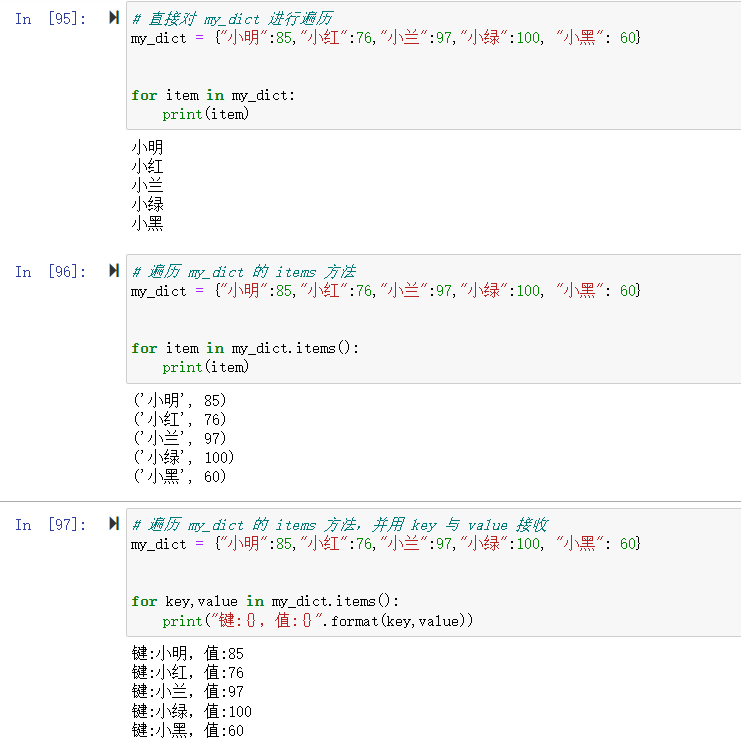
3.4.8 dictionary type - traversal key
my_dict = {"Xiao Ming":85,"Xiao Hong":76,"Xiaolan":97,"Little green":100, "Xiao Hei": 60}
for key in my_dict.keys():
print(key)
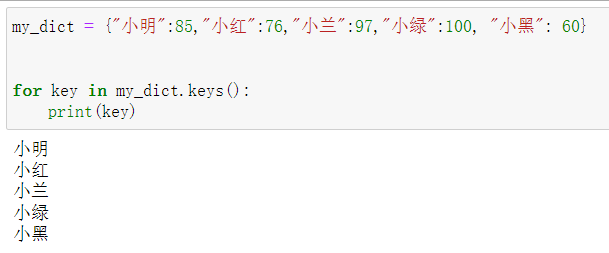
3.4.9 dictionary type - traversal value
my_dict = {"Xiao Ming":85,"Xiao Hong":76,"Xiaolan":97,"Little green":100, "Xiao Hei": 60}
for value in my_dict.values():
print(value)
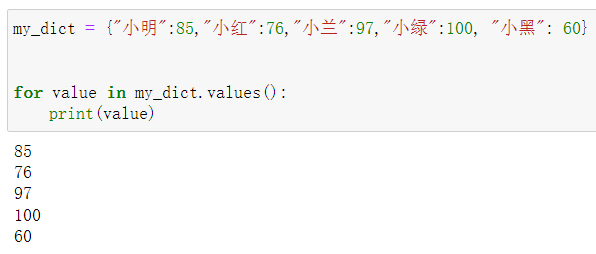
3.4.10 dictionary type - get method
my_dict = {"Xiao Ming":85,"Xiao Hong":76,"Xiaolan":97,"Little green":100, "Xiao Hei": 60}
x = my_dict.get("Xiao Hong")
print(x)

my_dict = {"Xiao Ming":85,"Xiao Hong":76,"Xiaolan":97,"Little green":100, "Xiao Hei": 60}
# An attempt was made to return the value of an item that does not exist
x = my_dict.get("Xiao Huang",45)
print(x)

3.5 data type - tuple type
tuples are basically used in the same way as lists
the difference is:
① the tuple uses parentheses (), and the list uses brackets [].
② and the elements in the tuple cannot be modified.
3.5.1 data type - definition tuple
① Declare a tuple object
my_tuple = (1, 2, 3) print(my_tuple) print(type(my_tuple))
my_tuple1 = ("www", "aaa", "ggg")
print(my_tuple)
print(type(my_tuple))
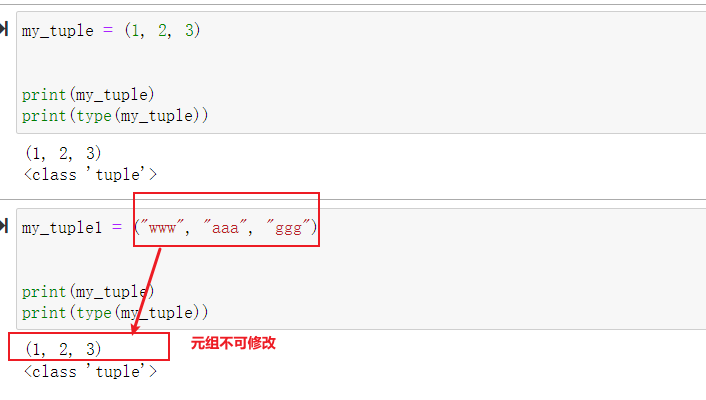
② Declare a tuple object with only one element
my_tuple2 = ("www", )
print(my_tuple2)
print(type(my_tuple2))

3.6 data type - set type
① a set is an unordered non repeating sequence, that is, there will be no repeating elements in the set.
② a set can be defined by braces {} or created by the set() function.
3.6.1 set type - create set
a = ["Piano","Barbara ","Cory","Barbara ","seven seven","Barbara ","Barbara ",] b=set(a) print(b)

4. Operator
4.1 operator - arithmetic operator
| Symbol | name | meaning |
|---|---|---|
| + | Addition operator | Calculate the sum of two numbers |
| - | Subtraction operator (minus sign) | Calculate the difference between two numbers (representing the opposite of a number) |
| * | Multiplication operator | Calculate the product of two numbers |
| / | division operator | Calculate the divisor of two numbers |
| ** | Power operator | Calculate the square of a number |
| // | Division operator* | Calculate the integral part of the quotient divided by two numbers, and the decimal part is rounded off |
| % | Modulo operator* | Calculates the remainder of the division of two positive integers |
>>> 9//two # Rounding 4 >>> 9 % 2 # Surplus 1
4.2 operator - string operator
① string - connection between strings
a = "my" b = "name" c = a+b print(c) >>>myname
② string - connection between numbers and strings
a = 123 b = "name" c = str(a) + b # str(a) converts the integer variable a into a string, otherwise an error is reported print(c) >>>123name
4.3 operator - comparison operator
| Symbol | name | meaning |
|---|---|---|
| > | Greater than operator | Judge whether the left value is greater than the right value |
| < | Less than operator | Judge whether the left value is less than the right value |
| >= | Greater than or equal to operator | Judge whether the left value is greater than or equal to the right value |
| <= | Less than or equal to operator | Judge whether the left value is less than or equal to the right value |
| == | equal operator | Judge whether the left value is equal to the right value |
| != | Not equal to operator | Judge whether the left value is not equal to the right value |
4.4 operator - assignment operator
| Symbol | name | meaning |
|---|---|---|
| = | Simple assignment operator | Assign the operation result on the right side of the operator to the left side |
| += | Assignment operator addition | Performs an addition operation and assigns the result to the left |
| -= | Subtraction assignment operator | Performs a subtraction operation and assigns the result to the left |
| *= | Multiplication assignment operator | Performs multiplication and assigns the result to the left |
| /= | Division assignment operator | Performs a division operation and assigns the result to the left |
| **= | Power assignment operator | Performs a meter calculation and assigns the result to the left |
| //= | Integer division assignment operator | Performs an integer division operation and assigns the result to the left |
| %= | Modulo assignment operator | Performs a modulo operation and assigns the result to the left |
i=10 i += 10 # Equivalent to i = i+10 print(i) >>>20
4.5 operators - logical operators
| Symbol | name | meaning |
|---|---|---|
| and | Logic and | The operator returns True only when the values on both sides of the operator are True. Otherwise, it returns False |
| or | Logical or | If both sides of the operator are True, it returns True; otherwise, it returns False |
| not | Logical non | True is returned only when both sides of the operator are False, otherwise False is returned |
score = -10
year = 2019
if (score < 0) and (year == 2019): # Only when the score is less than 0 and the year is equal to 2019 can it be executed
print("Enter database")
else:
print("Do not enter database")
>>>Enter database
5. Escape character
5.1 \t - equal to pressing a Tab key
print("\tPython")

5.2 \n - equal to pressing an enter key
print("Python\nJAVA\nC++\nJavaScript\nC#")

5.3 \ - continue to output multiple lines of code as one line of content
new_os = 'huawei' \
'HarmonyOS' \
' is coming'
print(new_os)

6. Formatting characters
%d integer output
%f floating point number output
%s string output
name = "Xiao Ming"
age = 18
score = 100
# Format a variable output
print("I am %s" % name)
# Format multiple variable outputs
print("I am %s this year %d Years old, I got it in the exam%.2f branch" % (name,age,score)) ># . 2 means to keep two decimal places
# format function
print("I am{},this year{},Got the exam{:.2f}".format(name,age,score)) # ":. 2f" Table > the numbers shown are floating-point numbers with two decimal places reserved
